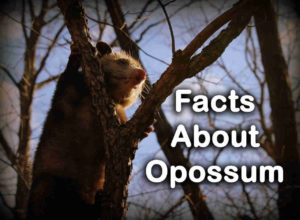Opossum Description, Behavior, Habitat, Reproduction, History & Interesting Facts

Opossum
1. Description:
The Virginia Opossum is North America’s only marsupial (a mammal with a pouch in which it carries its young). This animal is large and gray-brown, with a long, naked tail. It has long, hairless ears and an 18- to 22-inch (46 to 56-cm) prehensile tail. The animal has a pointed nose and canine teeth that most often are not visible.
Opossums are nocturnal (active at night) omnivores (animals that eat both meat and plants). They have small eyes and small ears, but a good sense of smell. They use their acute sense of smell to find food, and strong teeth and a long, pointed tongue to tear open hard-shelled food. In addition to insects and worms, they eat nuts, fruits, berries, eggs, birds’ eggs, small mammals (mice and rats) amphibians (frogs), reptiles (snakes), birds (baby pigeons), carrion (dead meat) and human garbage. The opossum is a scavenger that also hunts small animals for food.
2. Habitat:
The Virginia Opossum lives in a variety of habitats in the eastern United States and southernmost Canada. It is found from the Atlantic Ocean to the Great Plains, occupying forest edges, brushy fields, swamps and rocky areas. In Texas, its range is limited to the south.
3. Behavior:
Opossums are solitary animals with the exception of females with young (“joeys”) in the pouch. When frightened or threatened these animals play dead–they ‘play possum. A good description of how opossums play dead is: ‘The possum plays dead by lying on its side or back, drooling, and showing its tongue. It may even defecate. Its heart rate drops from about 300 beats a minute to less than 50, and it may even stop breathing altogether for up to 8 minutes until the threat passes.
Opossums are prolific breeders that have a high reproductive potential. There is one peak breeding season in the spring, but females can be fertile year-round. Females may give birth to as many as 13 young after a gestation period of 13 to 14 days. Young are born naked and pink, and their eyes and ears are closed. The babies must crawl into the pouch where they nurse for about two months and grow until they are able to leave the pouch. Opossums mature slowly, reaching sexual maturity in about 3 years. They can live to be at least 5 years old in the wild, but most die before they reach this age because of predators (coyotes, wolves, foxes) or human hunters. In zoos, they live an average of 8 to 10 years.
Opossums are not very active. They spend most of their time near their dens, curled up in a ball or stretched out, and appear to be asleep. They are capable of swimming for short distances, climbing trees and running along branches. Despite its low profile in many situations, the opossum is remarkably immune to snake venom–its body contains two different types of blood cells that can neutralize venom found in a snake’s mouth.
4. Reproduction:
An opossum has a pouch on the belly where it carries its young (joeys). Opossums have 13 teats for their 13 babies. The babies are born after a gestation period of 13 to 14 days. Young are born naked and pink and their eyes and ears are closed. The babies must crawl into the pouch where they nurse for about two months and grow until they are able to leave the pouch.
5. History:
The opossum is named after Indians in Virginia who hunted them in the early 1600s, an Algonquian word originally meaning “white animal.” Early settlers in America caught these nocturnal animals by attracting them with a fire; when the animals came close enough, they were caught in nets or killed with clubs or hatchets. European settlers in America did not eat opossums until they were taught to do so by Native Americans.
6. Interesting facts
- Opossums have 50 teeth! They also have a very long (18 in) prehensile tail for climbing trees and hanging on to branches!
- Opossums are the only marsupial found in North America, other than the Virginia opossum, which lives throughout the eastern U.S., but mostly in the south where it is common to find them living in houses, attics, crawl spaces, basements and garages. Other types of opossums live in South America and Australia, but they are not marsupials like our American opossums.
- Opossums feed on almost anything, including insects, worms, carrion (dead animals), nuts, berries and eggs. They are omnivores.
- The opossum has an uncanny ability to seem dead or unconscious despite of any stimulation around it. When caught or cornered by a predator it will “play possum” in order to survive– acting as if it is dead so the predator will lose interest and go away. It will appear to be almost lifeless and will not move no matter how much you poke it, but it is still very much alive and will play dead for only a few minutes before waking up again as if nothing happened. When an opossum is playing possum, its nostrils close and its heart rate slows down dramatically. This trick works because most animals in nature have an instinct which tells them not to mess with creatures that seem already dead – they find it repulsive.
- Opossums do not always sleep in the burrow they dig in your yard, despite popular misconception. They will sometimes sleep under the eaves of your house or in an old tree stump or even inside your house!
- Opossums are scavengers that feed upon many different types of food including nuts, berries and eggs! They are omnivores!
- Opossums were named after their odd-looking nose – which resembles that of an old-fashioned possum skin hat!
- The opossum is not a rodent. It belongs to the order of marsupials along with kangaroos and koala bears! They are the only marsupial found in North America!
- Female opossums usually give birth to about ten babies each year – usually 2-20 at a time – depending upon the species of opossum (the Virginia Opossum can have more than 20 babies at a time!).
- Opossums do not hibernate. They are active throughout the year, but they do slow down their metabolism when food is scarce.
More Facts about Opossum
Opossums have no control over when they play dead or for how long they do it
In fact, they are so caught up in pretending to be dead that they remain completely rigid even if they are poked or prodded. Then, when the coast is clear, they will suddenly come back to life and scamper off.
In other words, opossums have not evolved the ability to “play possum” like it’s commonly believed. It’s just that when threatened with danger they drop into their assumed death poses and remain frozen. They actually lack control of their bodies while doing this.
One opossum can eat the equivalent of 15,000 ticks in a single year!
A recent study from Virginia Tech in Blacksburg found that opossums are four times better at killing deer ticks than cats.
Since they live in Virginia, where Lyme disease is a problem, the researchers measured how long it takes for opossums, cats and gray foxes to kill deer ticks. They let 1,000 deer ticks crawl onto each animal and then checked them after 24 hours, 48 hours and one week to see how many were left alive.
The results were amazing:
It took the opossum an average of 6 hours to kill off all the ticks on its body.
Ticks, which are actually eight-legged arachnids (not insects) feed on the blood of mammals, birds and reptiles. They reproduce rapidly; a lone female tick can produce 3,000 offspring. Ticks are not just an annoyance; they can transmit several serious diseases to humans and other mammals such as Lyme disease and Rocky Mountain spotted fever.
Opossums are excellent tree climbers
They have a versatile prehensile tail that is like an extra hand for them. With 18 claws and opposable thumbs, they can grip to anything and climb up anything, including walls and ceilings. Opossums are also excellent swimmers, but stay away from deep water.
Read more Facts and Knowledge

